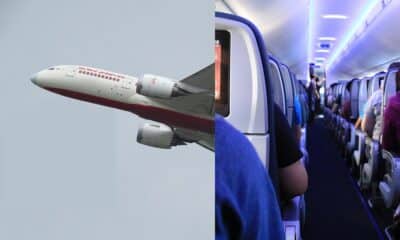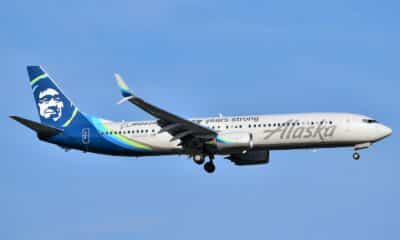Airlines
Crying baby on 29-hour flight sparks debate as travellers demand child-free flights
On a 29-hour flight from #NewZealand to #Berlin, a passenger voiced his affliction at a baby on the aisle who cried continuously through the #long-haul #journey.

On a 29-hour flight from New Zealand to Berlin, a passenger voiced his affliction at a baby on the aisle who cried continuously through the long-haul journey. Henry Beasley, a weary traveller, recorded his adventure in a video that he shared on TikTok.
Air New Zealand connects Auckland and New York for the first time ever(Opens in a new browser tab)
Balu Brigada band member from New Zealand requested that his “29-hour flight to Berlin” be “rated” by the audience. In the first video that was uploaded to the website, the passenger’s face was in focus as the camera recorded the baby’s cries in the background.
The remaining portions of the video featured a selection of various events that occurred over the course of the journey. Beasley remarked at the beginning of the clip that the infant was off to a “strong start” and expressed his response to the loud screaming.
The infant has some lungs, he added in-joke, before adding that they had “great projection.” At one point, Beasley referred to a prolonged scream that lasted a few seconds as “a great lengthy one here.”
Passenger wounded as Myanmar rebels shoot airliner(Opens in a new browser tab)
When the lights were dimmed later in the flight, Beasley made a joke: “His irritated eyes twitched, “Bring it on home now. He added the following text caption at the video’s conclusion: “excellent performance incredible stamina. 10/10.”
The TikTok video that went viral ignited a discussion about travelling with small children. The video received 220,000 likes, and one comment read: “Honestly, there should be kid flights and kid-free flights.” Another person added: “Children shouldn’t be permitted on flights longer than four hours.” Another person said, “I would pay EXTRA for planes without kids.”
https://cdn.jwplayer.com/previews/I9YZk0tu
Parents also agreed that small children shouldn’t travel on lengthy flights; one person wrote: “I know some families don’t have the option, but I never brought my babies or toddlers on flights. Everyone understands the pain. However, some commenters supported parents travelling with young children, stating that the experience is definitely more difficult for them.
One person said, “I feel awful for the passengers, but I also can’t imagine being ‘that parent’! The strain would be ridiculous.

Airlines
Air India’s last VVIP Boeing 747 now found a new home in USA

In a symbolic transition marking the end of a storied chapter in aviation history, Air India bid farewell to its last remaining Boeing 747-400 jumbo jetliners, once revered for ferrying dignitaries including prime ministers, presidents, and vice presidents.
The sale of these iconic aircraft to AerSale, a company based in the United States, signals the closure of a remarkable era for the airline.
The decision to part ways with the Boeing 747s was driven by practical considerations. Tata Group, the new custodian of airindia flights, deemed these majestic planes uneconomical to operate in today’s aviation landscape. As such, out of the four sold, two will be repurposed into freighters, while the remaining pair will be meticulously disassembled to harness their valuable parts.
The transaction, orchestrated by Mumbai-based Vman Aviation Services, underscores the strategic shift in Air India’s fleet management strategy under its new ownership. Tata Group’s decision to divest from the 747s reflects a commitment to optimizing operational efficiency and aligning with contemporary industry standards.
Skytech-AIC, a UK-based remarketing firm engaged by Tata Group, facilitated the sale of these iconic aircraft, marking the conclusion of their illustrious service with Air India. The airline’s last flight featuring the Boeing 747 took to the skies between Delhi and Mumbai in March 2021, encapsulating decades of distinguished service and indelible memories.
The allure of used aircraft parts continues to resonate across the aviation sector, offering operators a cost-effective alternative without compromising on quality or performance. The transfer of these aircraft to AerSale not only ensures their continued utility but also underscores the enduring legacy of Air India’s fleet.
Airlines
A software error caused grounding the entire airline fleet

On Wednesday, the U.S. Federal Aviation Administration (FAA) issued a ground stop advisory for all Alaska Airlines and subcarrier flights due to a software issue, disrupting travel plans for passengers.
The FAA directive, which prohibited the departure of Alaska Airlines mainline and subcarrier flights, was implemented as a precautionary measure following the detection of the software problem. The ground stop was initiated after Alaska Airlines encountered difficulties during a system upgrade related to the calculation of weight and balance for their flights.
As a result, the airline opted for a temporary suspension of all its operations to address the issue and ensure passenger safety. Alaska Airlines promptly issued a statement acknowledging the incident and expressing their commitment to resolving the matter swiftly. “This morning we experienced an issue while performing an upgrade to the system that calculates our weight and balance.
Out of an abundance of caution, we requested a ground stop for all Alaska and Horizon flights, which was instituted at approximately 7:30 a.m. PT,” the statement read. Passengers affected by the disruption voiced their concerns on social media platforms, prompting Alaska Airlines to reassure them of their efforts to minimize the inconvenience and expedite the resumption of flights.
Following approximately an hour-long interruption, the FAA lifted the ground stop order, allowing Alaska Airlines and its subcarriers to resume normal operations. However, it was clarified that SkyWest, which provides regional service for Alaska Airlines and other carriers, was exempt from the ground stop and continued its flights unaffected.
Aerospace
Which is bigger 777x or 787 aircraft ?

The 777X is a new series of the Boeing 777 family and is designed to be larger and more efficient than its predecessor. It features two variants: the 777-8 and the 777-9, being the larger of the two.
The Boeing 777X emerges as the larger sibling within the Boeing family, representing a significant leap forward in both size and efficiency. Comprising two variants, the 777-8 and the 777-9, the latter takes the crown as the larger of the two. With its expansive fuselage and impressive wingspan, the 777X is tailored for long-range journeys and boasts a substantial passenger capacity.
On the other hand, the Boeing 787, affectionately known as the Dreamliner, occupies a niche in the market as a smaller yet formidable aircraft designed for medium to long-range flights. Its distinguishing feature lies in its composite fuselage, a technological marvel that renders it lighter and more fuel-efficient compared to conventional aluminum counterparts. The Boeing 777X is larger than the Boeing 787 aircraft.
When it comes to passenger capacity, the 777-9 reigns supreme, typically accommodating a sizeable contingent of 400-425 passengers in its standard configuration. In contrast, the 787, with its more modest dimensions, typically carries between 240-290 passengers, depending on the variant and layout.
One of the remarkable innovations introduced with the 777X is its folding wingtips, a feature designed to address the logistical challenges of accommodating such a large aircraft in conventional airport gates. These folding wingtips enable the 777X to retract its wings, allowing it to fit into gates designed for smaller aircraft while still reaping the benefits of an extended wingspan during flight, thereby enhancing fuel efficiency and operational flexibility



























